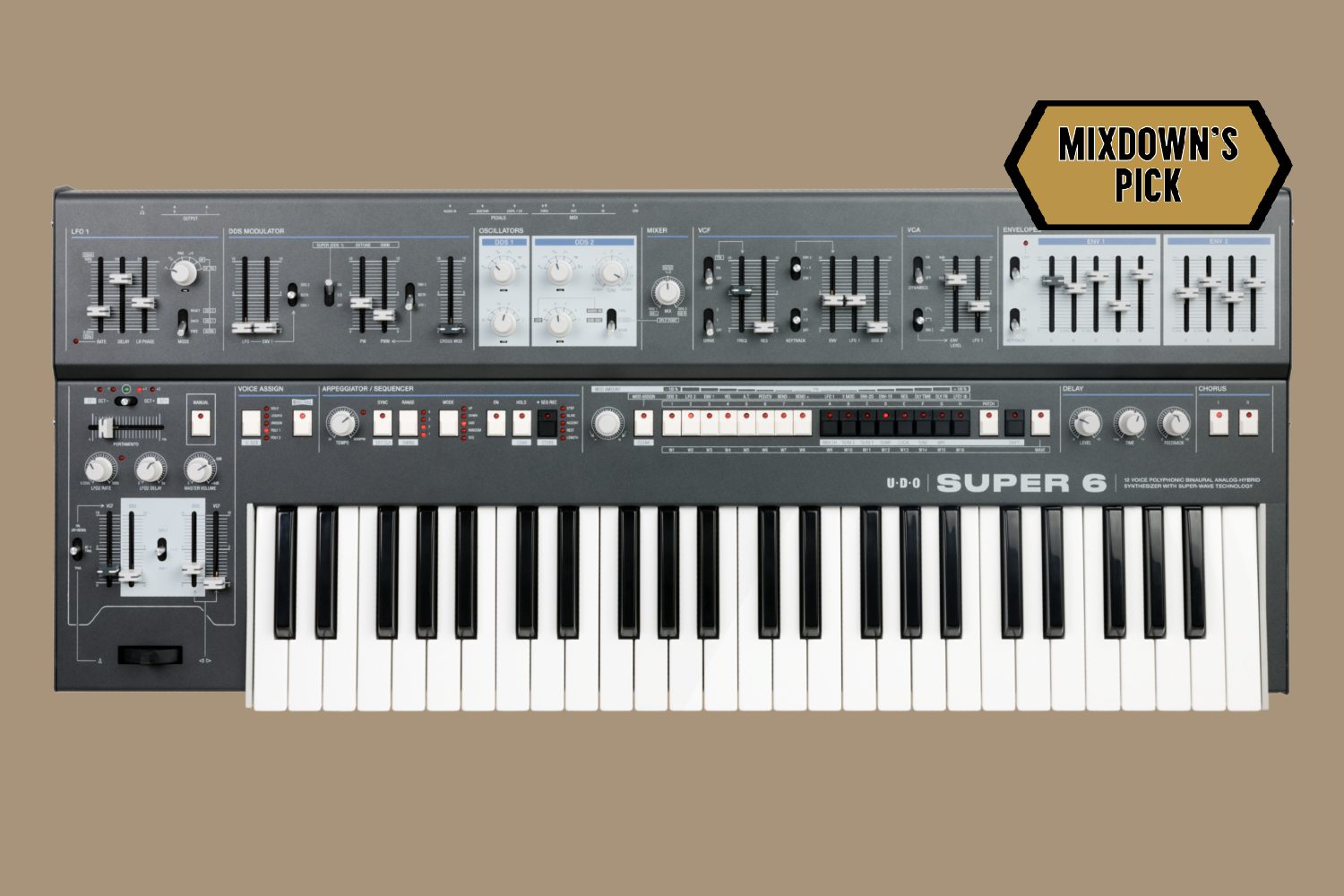Innovative Music | RRP $4,699
It’s not uncommon that a synthesiser feels rushed to market, a little half-baked with buggy features that were over-promised in marketing or UI with glaringly obvious flaws that needed another round of revision. It’s quite the opposite here. UDO’s Super 6 is painstakingly refined. Both the physical design and UI feel considered and nuanced, and most importantly the sounds it can produce are just as sophisticated.
Playing the Super 6 for the first time, you’re welcomed in by the familiar design and the closer you look, there’s more than immediately meets the eye.
Read more product reviews here.
Reminiscent of Roland’s golden era of synths, the Super 6 is the ideal combination of aesthetically inspiring and functional to use. The build quality has the deluxe feel you’d expect of its price tag; the tact switches are satisfying to toggle and the sliders feel precise and smooth in motion, with just the right amount of resistance. It’s amazing how much functionality is packed into a menuless interface with various dual-purpose functions that all feel logical in use.
Binaural beats became buzz words a few years back with promises of brain entrainment to help everything from focus and concentration to deep relaxation. While the clinical tests of its benefits were lacklustre, the fact remains that having two separate signal paths for left and right channels coming out of a synthesiser opens up an ocean of potential movement and sonic experience.
When operating in binaural mode the voices are halved, giving the user a wealth of choice between highly complex binaural sounds or a traditional stereo image with a decadent 12-voice polyphony. Having precise control over the phase is an enticing offer and it’s just one of the benefits of the complex oscillator design.
The FPGA oscillators offer modern flexibility but with a robust character, there’s no glitchy aliasing or harsh digital edges. This is due to their incredibly high 50MHz sample rate and allows for greater phase precision and ‘natural-sounding frequency modulation’. Even the cross mod between oscillators is more reminiscent of analog VCOs than the usual sharp digital sting wavetable oscillators are often associated with. Both oscillators one and two can be dynamically dispersed in the stereo field for thicker detuned tones.
Supersaw fans are in for a treat, but this is much more than a one-trick-pony for trance leads. Aside from all the classic oscillator shapes being able to be spread, the alternate single cycle waveforms (including custom user waves) can also be transformed into ‘super’ waveforms. Oscillator two isn’t quite as fully featured as oscillator one (it doesn’t include the single cycle waveform option) but it does feature a variable pulse-width wave and noise. All this technical sophistication results in a lush, rich-sounding core building block to construct a sound from.
Upon initial announcement, the Super 6 caught synth nerds’ attention everywhere as it boasted a modern re-creation of the SSM2044 filter; an iconic sound featured in the Korg Trident and Polysix, the Emulator, and the PPGWave 2.3. UDO has delivered as the four-pole, 24dB filter with low pass, high pass, or bandpass modes really brings the analog character of the Super 6 to life. They fizz through swirling pads and strings, they bubble along modulated leads and can growl on unison basslines with a switchable pre-filter drive to add extra punch when needed.
The Super 6 has two LFO’s and beyond their basic function as modulation sources (they have dedicated sliders for LFO1 to modulate both the oscillators, the VCFs and the VCAs), they have some additional functionality in the form of high frequency (audio-rate) speeds. In this mode LFO1 essentially becomes a third oscillator as it can track the keyboard. LFO1 has four basic shapes (triangle, square, random, or saw) but can also copy the single cycle waveform of DDS1. It can be free running, reset on each note or cycle once (useful for percussive sounds).
LFO1 also triggers independently for each of the six ‘Super’ voices, resulting in dynamic variance from voice to voice in binaural mode. LFO2 is a more rudimentary triangle shape but is useful for classic modulation options with corresponding tact switches to modulate the oscillators, VCF, or VCA, as well as being just one of the sources in the modulation matrix.
The mod matrix is cleverly integrated into the patch selection tact switches (selecting custom DDS1 waveforms is the third function of these switches). Select a source, select a destination and use a dial to determine the amount. LED’s above the tacts correspond to the dial as a visual cue for the affected source. Alternatively, you can enter mod assign mode, select and hold a source tact then move a parameter on the front panel you would like to modulate, then dial in the amount. Like so much of the Super 6 experience, it’s quick and simply a treat to use. I could click these springy tacts and tweak these deluxe sounds all day long!
Being their first instrument, UDO have done well to give the Super 6 an air of legacy. Combining the vintage aesthetic design with state-of-the-art technology, it feels like a synthesiser that will stand the test of time. The sound is so classy, the interface is oh so smooth.
The hi-fi effects section and polyphonic step sequencer/arpeggiator provide the finishing touches to the crazy patches you can create. It does classic analogue sounds so well, and its binaural capabilities offer unique sound design possibilities that will surely be gracing sound art installations and sci-fi soundtracks everywhere soon enough.
Hybrid synths have long represented a best of both worlds ideal that sometimes sadly falls short, but not here; the Super 6 is a tangible example of this dream realised. Here at Mixdown, we’re dreading the day we have to give our demo model back and certain staff members are already reconfiguring their finances to accommodate a purchase.
Head to UDO Audio for more information. For local enquiries, get in touch with Innovative Music.







